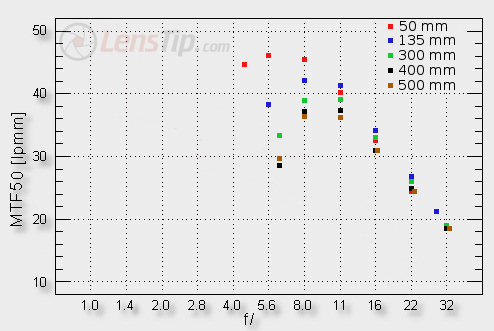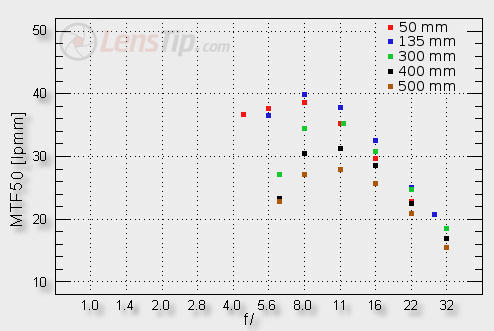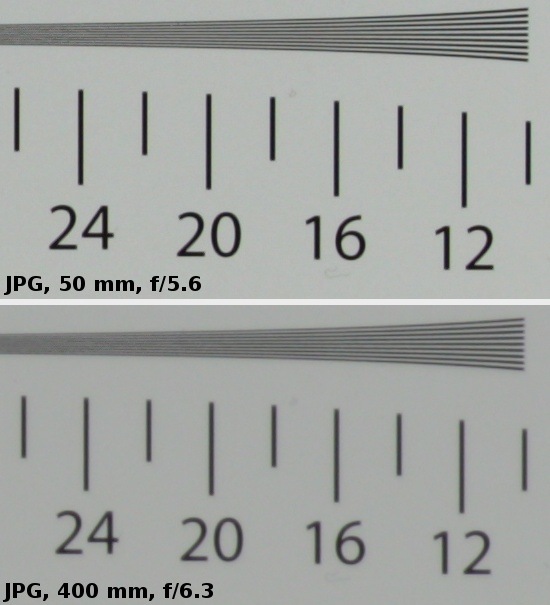Sigma 50-500 mm f/4.5-6.3 APO DG OS HSM
4. Image resolution

Perhaps the most important thing that should be done is a comparison between the results, presented here, and those obtained for such lenses as the Canon 100-400L or the Sigma 120-400 mm OS and the 150-500 mm OS. It is difficult, though, because those lenses were tested on an EOS 20D so a camera with a significantly less densely packed sensor. As the tests of our lenses are based on unsharpened RAW files such a comparison is still possible. The value deemed by us as the decency level, so 30 lpmm in the case of the 20D and about 34 lpmm in the case of the 50D, and the maximum results reached by the best “primes” which, on the 20D, are near 44 lpmm and on the 50D – near 52 lpmm, constitute good reference points for this kind of comparison. How well does the tested Sigma fare from such a perspective?
Please Support UsIf you enjoy our reviews and articles, and you want us to continue our work please, support our website by donating through PayPal. The funds are going to be used for paying our editorial team, renting servers, and equipping our testing studio; only that way we will be able to continue providing you interesting content for free. |
- - - - - - - - - - - - - - - - - - - - - - - - - - - - - - - - - - - - - - - - - - - - - - - -
At 50 mm focal length the situation is very good. We can get very sharp pictures right from the maximum relative aperture. The lens doesn’t break any resolution records here but it would be unreasonable to expect that much from an ultra-telephoto device with a 10x high zoom ratio.
The picture quality decreases as the focal length gets longer. In fact we knew about that trend from the very beginning because of laws of physics and the tested lens’s parameters. Resolution graphs, presented in our tests, are so to speak the result of two factors – the influence of optical aberrations and diffraction. Near the maximum relative aperture aberrations constitute the main restriction. On significant stopping down optical aberrations are minimized but then the diffraction comes to the fore. As a result, our curves are parabola-shaped with both ends pointed downwards. Firstly the image quality increases because we limit aberrations by stopping down the lens, then it decreases because aberrations are minimized but the narrowed aperture makes the resolution drop due to diffraction. It is also worth noticing that fast lenses reach the peak of their possibilities after being stopped down by about 3 EV.
The Sigma is no exception to this rule. In its case, on stopping down by 3 EV, optical aberrations are limited to low values. The problem is that the maximum relative aperture of the Sigma at the longer end amounts to f/6.3. When you stop it down by three points of exposure value you find yourself at the level of f/13. For such a value the diffraction becomes a huge restrictive factor so even the sharpest “prime”, tested on a 50D, won’t be able to exceed significantly the level of 40 lpmm there. There’s simply no getting away from it – the Sigma can’t exceed 40 lpmm because near the maximum relative aperture it will be stopped by aberrations and on stopping down and minimizing their influence it will be restricted by laws of physics in the shape of diffraction.
We already know there will be no record-breaking results. After all no telephoto zoom is able to achieve that much for the reasons described above unless it is f/2.8 fast. When we test the Sigma 200-500 mm f/2.8 we’ll see…
As records are impossible here the question about the level of usefulness becomes even more important. Here the Sigma passes the test with a positive result. At 300 mm the image is useful even from the maximum relative aperture and on stopping down it reaches the borderline between good and very good level. On passing to 400 mm we see the image quality deteriorating – you can hardly speak about its usefulness any more at the maximum aperture but on stopping down just a bit the situation gets a lot better. What’s important and interesting at the same time, when you go from 400 mm to 500 mm you can’t notice any change in the image quality. At the maximum focal length, after stopping down to f/8.0 (so by 2/3 EV), we can still enjoy a really good image quality.
The Sigma surpasses noticeably the 150-500 mm OS model here, which, on going from 400 mm to 500 mm, had a lot of problems with reaching similar results. What’s more, even after significant stopping down to f/11 the 150-500 mm model at the maximum focal length barely brushed against the usefulness level. The Sigma 50-500 mm OS doesn’t have any problems with exceeding it and, after all, its focal length range is a lot wider.
When you compare the tested lens to the Sigma 120-400 mm OS we see a very similar situation. The Sigma 50-500 mm OS at 400 mm fares better than the 120-400 mm OS model and additionally we get a useful 500 mm at our disposal.
How does the Sigma compare with its most dangerous rival, the Canon 100-400L? With the Sigma we get a wider range and a bit better stabilization but this device is a little bit more expensive. As far as the image quality is concerned, the Sigma loses…the Canon at 400 mm is not only faster but also fully useful up to the maximum aperture. Near f/8 it has results at the level of 35 lpmm and it should be emphasized that it was tested on the sensor of the EOS 20D. The Sigma reaches 36 lpmm but only on the 50D’s sensor with 15 million pixels. If we tested the 100-400L on the 50D we think for the combination of f/8.0 and 400 mm it would exceed easily the level of 40 lpmm. The 400 mm focal length is definitely better in the case of the Canon. The Sigma, however, boasts 50 mm and 500 mm focal lengths for a change which the Canon lacks…
Let’s progress to the frame edge performance now.

No wonders here but, after all, nobody expected them anyway. If a telephoto zoom with 10x high zoom ratio performs well in the frame centre, it is bound to have a weak spot somewhere else. In this case the frame edge performance in the 400-500 mm focal lengths range can be deemed as such because you can hardly call it fully useful. The Sigma loses to the Canon 100-400L which, at all focal lengths and apertures, can give useful images even at the edge of an APS-C/DX sensor.
However, once again the Sigma 50-500 mm OS compares favourably with both Sigmas 120–400 mm OS and150–500 mm – although the tested lens is also the most expensive one, it gives us a better image quality and a wider range of focal lengths.
 |






